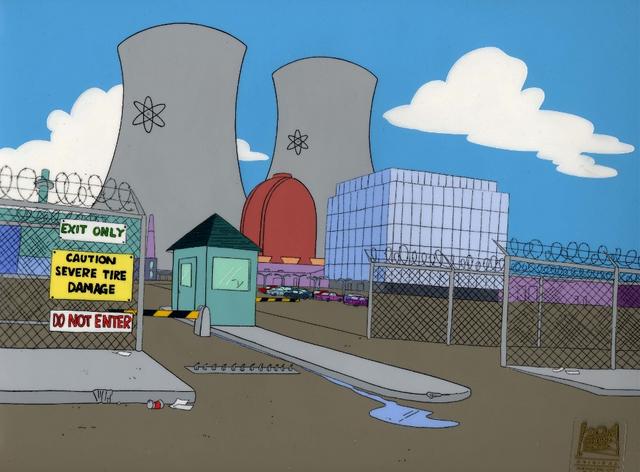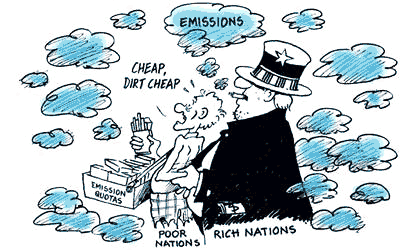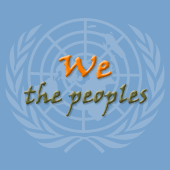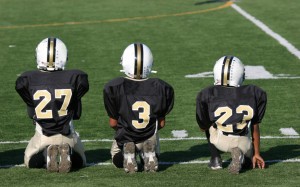When I was younger, my family and I would constantly travel from Maryland to New York to see my grandparents in Massapequa, NY. Beautiful town by the by. That’s not Massapequa up there–that’s Hong Kong.
On the way up there we had to go thru both New Jersey and New York City. I recall being told to roll up the windows–not because we were passing a cemetery(har har) but we were passing through some of the dirtiest air on earth. I remember seeing towering smoke stacks–reminiscent of the Springfield Nuclear PowerPlant on The Simpsons.

While surely they were not this big (perhaps there are that I have not seen) but it was and is a disturbing problem. The proposition of Flexible Mechanisms in the Kyoto Protocol would essentially commodify climate change.
Watch the video. Now for those who don’t know Captain Planet is a kids show from the mid 90s about kids fighting pollution–kind of like our little 15 person group–but you know, with magical rings that summoned elements of the earth. Perhaps if Dickinson can’t afford to give us Kindles to save the planet, they can get us Planeteer rings. Anywho! This is a GREAT example of commodifcation–but in a way to spread the message.
The ways in which flexible mechanisms work is that another country would buy credits from another country whose emissions are below the budget and use them to lower their emissions theoretically. There are several problems with this:
-First off, by having this loophole countries will think it is okay to just buy credits rather than actually attempt to be proactive–essentially giving them free range to keep polluting as long as they can purchase the credits.

A Nice Little Political Cartoon For Visualization
-Second, by allowing nations to purchase the credits, it will also open up the doors for generous donations from businesses to come in order for them to keep up their polluting ways.
-Another form of this is through Clean Development Mechanisms or CDMs that would allow developed countries to invest in sustainability efforts and thus earning them credits. While it makes the third world countries more sustainable it leaves the door wide open for developed countries to continue to pollute.
-Lastly, and probably most importantly, the idea of carbon emissions being on the trading block is just plain disturbing.
Overall, I find the flexibility mechanisms to quote the famous Steve Jobs “a bag of hurt” and an easy cop out for nations that are able to afford to do so.
Tags: Captain Planet, Flexible Mechanisms, Kyoto Protocol, The Simpsons
The Earth’s ecosystems are under attack by many virulent anthropological threats including global climate change that will make the Kyoto 2 Conference in Copenhagen in December of 2009 a critical juncture for global mitigation and adaptation programs. Can the Kyoto Protocol save Mother Earth’s Immune System?

Adapted from: http://www.mailmedia.de/presse-downloads/logos/patient-erde_72dpi_RGB.jpg
The careful implementation, monitoring, and expansion of existing Kyoto Protocol carbon sink program have the potential to effectively reduce overall green house gas emissions and bolster ecological resilience.
Under the current agreements of the Kyoto Protocol Annex I countries (developed countries) have to reduce their green house gas emissions to below their 1990 levels. In order to reach these goals there has been a large focus, by many countries, on green technological solutions and economic solutions like using international carbon markets or administering carbon taxes as was described in the 2008 CRS Report for Congress. These strategies are important for mitigating climate change. However, there is no use in investing in a drug if the patient keeps getting sick. Similarly the world needs to not only invest its time, energy, and money into emission reducing procedures, but also focus on preserving the resilience of the world’s ecosystems. This way mother earth is not like an AIDS patient that is vulnerable to any environmental sickness or disaster without having a healthy immune response. There needs to be a higher priority for investing in carbon sinks to protect natures resilience and carbon sequestration abilities. The Kyoto Protocol suggests that changes in land use, land use change, and forestry (LULUCF) is one method where countries can receive additional emission allowances, because the protection of these areas act as a natural green house gas sink.
Developing nations are not bound to protect their natural lands by any international mechanisms under the Kyoto Protocol. The Kyoto 2 Conference is an opportunity to expand upon the existing avenues in the Kyoto Protocol outlined in Uniting on Climate : A Guide to the Climate Change Convention and the Kyoto Protocol. Annex I countries can invest in carbon sinks through the Clean Development Mechanism (CDM) or Joint Implementation (JI) programs to reduce green house gas emissions from within other developing or developed nations. There is an independent committee that reviews these programs under the current framework. For this to be an effective evaluation process, this body needs to consist of a diverse and interdisciplinary group of experts (especially climate scientists and ecologists) to assure that these programs are critically reviewed for their contribution to reductions in green house gases in a manner that is ecologically and socially responsible.
Unfortunately, there needs to be more stringent requirements for carbon sinks to be properly effective and ecologically healthy. A higher priority should be given for the protection of existing ecosystems rather than for afforestion programs, which creates forest that wasn’t there before. This is because afforestation programs are often unhealthy and lack biodiversity.

Adapted from: http://www.greenpeace.org/raw/image_full/international/photosvideos/photos/indonesia-forest-destruction-palm-oil.jpg
Preserving ecosystems maintains ecological services and resilience, which translate into recognizable social and economic benefits in helping mitigation and adaptation goals to address global climate change. To name a few: some ecosystems act as flood barriers in coastal zones, while others provide habitat for local wildlife, which sustains local people and supports the tourist industry as is described in the 2000 Millennium Ecosystem Assessment. Afforestation and reforestation programs on the other hand are an industrial solution that can end up causing many side effects such as the displacement and deprivation of indigenous peoples as well as local flora and fauna. The end result can be devastating just like chemotherapy is for a cancer patient. The establishment of new forest tends to centralize the land control to foreign interests, which tend to exploit the ecosystem at the expense of the local and ecological communities. In order for the land use to be sustainable and continue to provide green house gas emissions it must make provisions that will involve indigenous people. In Indonesia for example, there are huge tracts of forest that are being deforested and developed into large scale palm oil factories against the wishes of the people as was documented in the Global Value Chain: Palm Oil Video video.
Developed countries can make a difference by buying rights to land containing tracts of forest and various other ecological zones in order to preserve these ecosystems that would otherwise be destroyed.
Funding ecosystem preservation (like protecting rain forest) coupled with investment in ecotourism management of natural areas seems to me to be a possible way that could be attractive to Annex I investments. These operations would need to be carefully monitored by both the host country and the investing country. If done correctly this has the possibility of providing local jobs for park protection and management, while providing an opportunity for developed nations to be invested in ecotourism destinations for its population.
Finally, there is a need for the environmental and ecological assessments of carbon sink programs to determine what would be best for preserving the existing biological community to compliment regional and global conservation strategies. Ultimately, there is a need for a holistic approach that prioritizes preservation, but also includes complimentary economic mechanisms. A good example of a country that has adopted a viable approach is Costa Rica, which Thomas L. Friedman describes in the New York Times opinion article (No) Drill, Baby, Drill. This exact model not be possible for all countries given the differences in natural endowments and economic capabilities, but it’s success reflects the importance of nurturing resilience and not just relying on industrial cures.
Tags: Carbon Sequestration, Holistic Approach, Kyoto to Copenhagen, LULUCF, Philip Rothrock, Resilience
Indigenous Peoples Organizations (IPOs) are an important constituency in international climate change negotiations today. Perhaps because as a collective group, indigenous peoples have been dominated and neglected for hundreds of years, often uprooted from their lands and treated disrespectfully. Or maybe on some level, we realize that, as a collective group, indigenous peoples around the world might hold an understanding of the interconnectedness Brett Shollenberger speaks of in his blog.Perhaps we unconsciously feel they might be able share with us some of the natural wisdom we’ve let slip our minds as we’ve aimed to conquer our neighbors in the name of wealth. Or maybe, it’s simply because they represent a minority whose lives will be greatly affected by any climate change related decision, and up until a few years ago, they have not been heard.
As a constituency group, the indigenous peoples organization is coordinated by the International Alliance of Indigenous Tribal Peoples of the Tropical Rainforests.
The objectives of the alliance are to:
-promote full recognition of the rights and territories of indigenous and tribal peoples;
-promote the development of indigenous and tribal peoples and their participation in decision and policy making;
-establish effective networks between indigenous peoples at regional and international levels;
-exchange information and experiences to empower Alliance members to advocate for the rights of indigenous and tribal peoples, enabling them to impact upon processes falling within the complex UN system, and the policies and decision-making of developmental agencies and multi-lateral development banks;
-promote worldwide solidarity between indigenous and tribal peoples.
In November of 2003, representatives of indigenous peoples around the world came together before the COP9 of the UNFCCC and created a joint statement to present to the UNFCC. Together they said:
“There must be full and effective participation of Indigenous Peoples in the UNFCCC by now.”


Discussions around starting a UN Permanent Forum of Indigenous Peoples began in the late 1980’s. The idea was first official suggested at the 1993 World Conference on Human Rights in Vienna, and from what I can find, the Permanent Forum held its first official meeting in 2002. In 2007, the Forum introduced the Declaration on the Rights of Indigenous Peoples noted to be the most comprehensive statement of indigenous rights ever created. The United Nations General Assembly adopted the UN declaration in September 2007.
Although their existence and importance has been formally recognized, indigenous peoples are still fighting for their unequivocal right to participate in the decision-making processes surrounding climate change. Opening new veins communication and finding new forums for discussion surrounding their rights and involvement seem dominant on their agenda, as well as publicizing research on the effects of climate change on specific indigenous cultures and groups.
While a considered a relatively small constituency group, the breadth of the indigenous peoples organization must not be underestimated. The Alliance represents indigenous peoples from over 57 countries around the world and a full array of diverse regions, environments, cultures and values. Still, despite their differences, they stand together and fight for their right to be heard.

Indigenous peoples aim to protect their heritage and their livelihoods by protecting the often-fragile environments within which they live. As a group historically denied their basic rights as human beings, they are asking the rest of us to finally listen. They seem to act not out of anger and resentment at their mistreatment, but out of brotherhood and the severity of the issues at hand. The time has come to release the embarrassments of yesterday, and embrace the collaboration of today.
“Collaboration is really important. The moment that we realize that we are connected to creation, to Earth, the Earth as our cosmic common mother, then by definition you become my brother and not my enemy. Doesn’t matter what color skin you are or where you come from in the world.”
-Gkisedtanamoogk, Wampanoag elder, Teacher, and Indigenous Nation cultural advocate
The question stands… Will we listen?
Tags: coalitions, COP15 Resources, Danielle Hoffman, indigenous peoples, interconnectivity
In the past, we’ve seen a correlation between more economic development, more energy use, and more emissions of green house gasses. “The challenge of addressing climate change is to break the link between economic development and greenhouse gas emissions” (Uniting on Climate Change, UNFCCC 2007). The key here to curbing the impacts of climate change is sustainable development.
The Clean Development Mechanisms (CDMs) outlined by Fletcher and Parker in the CRS Report for Congress help to fund sustainable development projects in developing countries. Under the Kyoto Protocol, developed countries have agreed to cap their greenhouse gas emissions to levels less than that of their 1990 levels of emissions. These countries can meet their emissions standards by:
– cutting emissions domestically
-trading emissions with other developed countries
-or, through the CDM where they receive Certified Emissions Reduction credits (CERs) by investing in emission-cutting projects in developing countries
The CERs must be in addition to domestic emissions cutting. In other words, each developed countries must make efforts towards cutting emissions domestically, and cannot solely buy up carbon credits from emissions that were cut abroad.
Although the Kyoto Protocol designed the CDM to offer an alternative to help developed countries in cutting emissions, it also has a positive effect on the developing countries. The CDM gives the developing countries the funds it needs to invest in green energy that will put these countries on the “soft energy path,” as opposed to the “hard energy path” that countries such as the US and those in Western Europe have found themselves in. As outlined in the Stern Report,
action taken to reduce emissions sooner in the development process rather than later will be less costly for the economy and for the environment.
Not only will sustainable developm ent projects in the developing world help to achieve a higher level of environmental quality, it will also spark economic growth and lead to a higher standard of living. This includes the basics of survival that many countries lack: Such as the access to water, sturdy, energy efficient homes, and energy for the means to harvest food. Through participation of the CDMs, the funds allocated towards sustainable development could lead to poverty alleviation in the developing countries. Now, we need to get everyone on board the Kyoto Protocol to maximize the potential benefits of sustainable development… US? Hello?
ent projects in the developing world help to achieve a higher level of environmental quality, it will also spark economic growth and lead to a higher standard of living. This includes the basics of survival that many countries lack: Such as the access to water, sturdy, energy efficient homes, and energy for the means to harvest food. Through participation of the CDMs, the funds allocated towards sustainable development could lead to poverty alleviation in the developing countries. Now, we need to get everyone on board the Kyoto Protocol to maximize the potential benefits of sustainable development… US? Hello?
Tags: Clean Development Mechanism, climate change education, COP15 Resources, Flexible Mechanisms, Grace Lange, soft energy path, sustainable development
When I was a freshman in high school I used to sit the bench during varsity basketball games. I would play my heart out at practice throughout the week and come game-day observe how my time and efforts would pay off. Even without playing a minute all year, I contributed to the outcome of every game through my hard work on the practice courts and my encouragement of the other players during games. This type of participation and mindset will be shared by various NGOs at the 15th Conference of the Parties to the UNFCCC.

In varying degrees, we are all stakeholders of global climate change. Yet not everyone can be an elected government official or a leader in industry to have the influence or power to negotiate for change (After all, only five players per team can play at once during a game of hoops). So where does that leave the rest of us? Well, one option is to remain inactive while the threats of climate change continue to rise. A more preferred option, however, is to get involved with the various organizations that exist at the local, national, and international level to fill this void! Luckily for us, we are doing precisely that as a Research and Independent NGO (RINGO), one of the five NGO constituencies recognized by the COP climate change regime.
But our purpose and mission at the conference in Copenhagen will be much different than that of the other NGO constituencies (Environmental NGOs [ENGOs], Business and Industry NGOs [BINGOs], Local Governmental and Municipal Authorities [LGMAs], and Indigenous Peoples Organizations [IPOs]). Instead of conducting research they will be concerned primarily with:
- lobbying government delegates;
- circulating information and position papers;
- working with the media;
- hosting side events;
- making interventions during debates; and
- monitoring developments in the negotiations
(Yasmin and Depledge 2004). But the way in which each constituency does so differs based on the particular interests of each NGO making up the constituency.

LGMA advertisement
ENGOs active in the climate change regime, for instance, are more often than not a part of the Climate Change Action Network (CAN). CAN’s members present a common front in aiming to “promote government and individual action to limit human-induced climate change to ecologically sustainable levels.” To this end, ENGOs are able to intervene more during formal debates as they share similar sentiments. BINGOs, on the other hand, can be separated into two broad categorizes. First, green businesses are corporations that are concerned with the impact businesses have on climate change and can view the threat of climate change as a business opportunity. Conversely, gray businesses fear that cuts in greenhouse emissions will have devastating impacts on their businesses. These industries, such as automobile, oil, and coal, promote scientific uncertainty and economic costs in efforts to slow down negotiations.
No matter what the NGO is founded on, each and every NGO seeks a greater involvement in the negotiation process. Sometimes this is best achieved by presenting themselves as a single constituency (despite the differences highlighted above) for the sake of being heard. But this is often a difficult thing to accomplish due to the sheer number and diversity of NGOs concerned with climate change negotiations (approximately 985 NGOs representing a broad spectrum of interests from those described above to faith groups, labor unions, women’s organizations, and youth groups). Not to mention the other groups of parties and observers recognized by the convention. Nevertheless, while the five NGO constituencies recognized by the climate change regime are not actively involved in the negotiations they do have the opportunity for their voice to be heard. And, similar to my perspective of sitting on the bench, these observers ultimately have an impact on the game.
Tags: climate change, COP15 Resources, NGOs

Your Comments